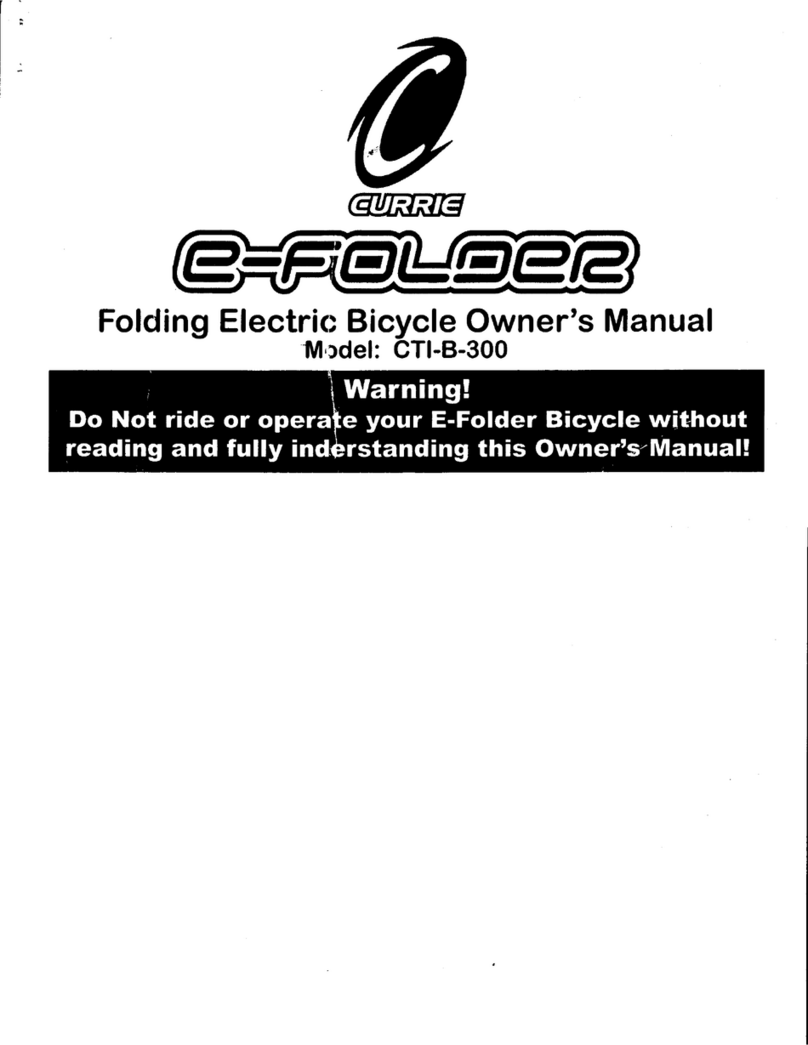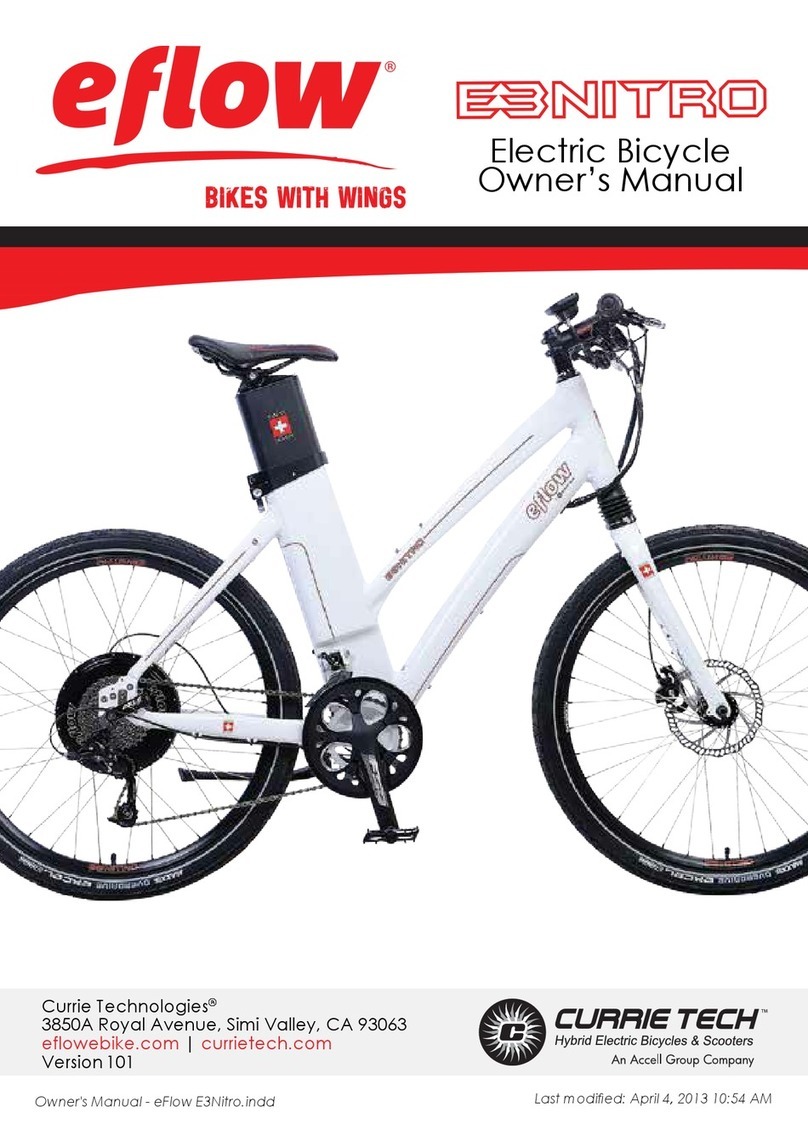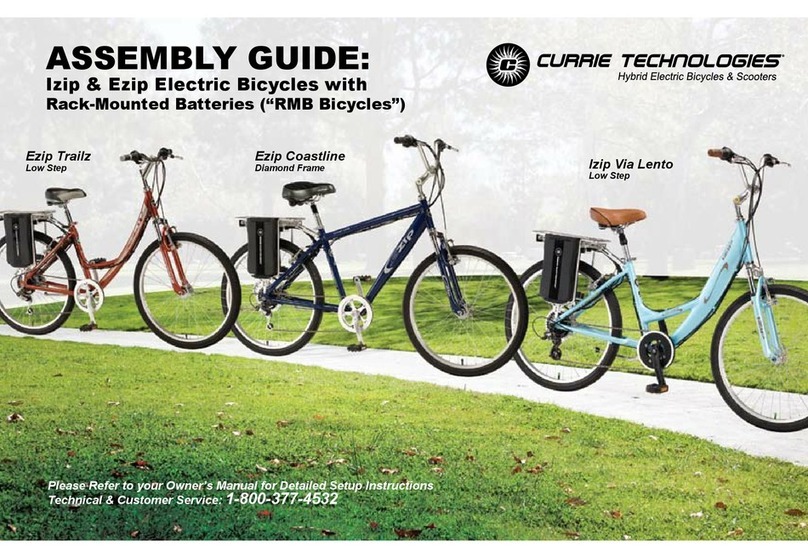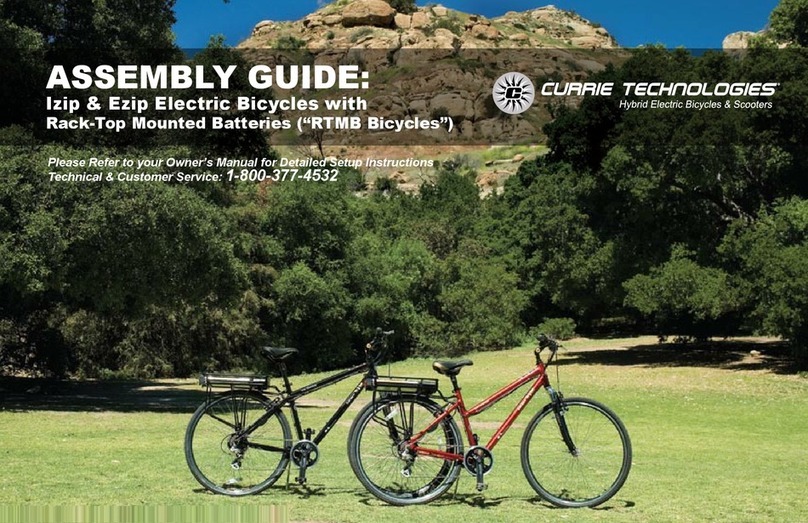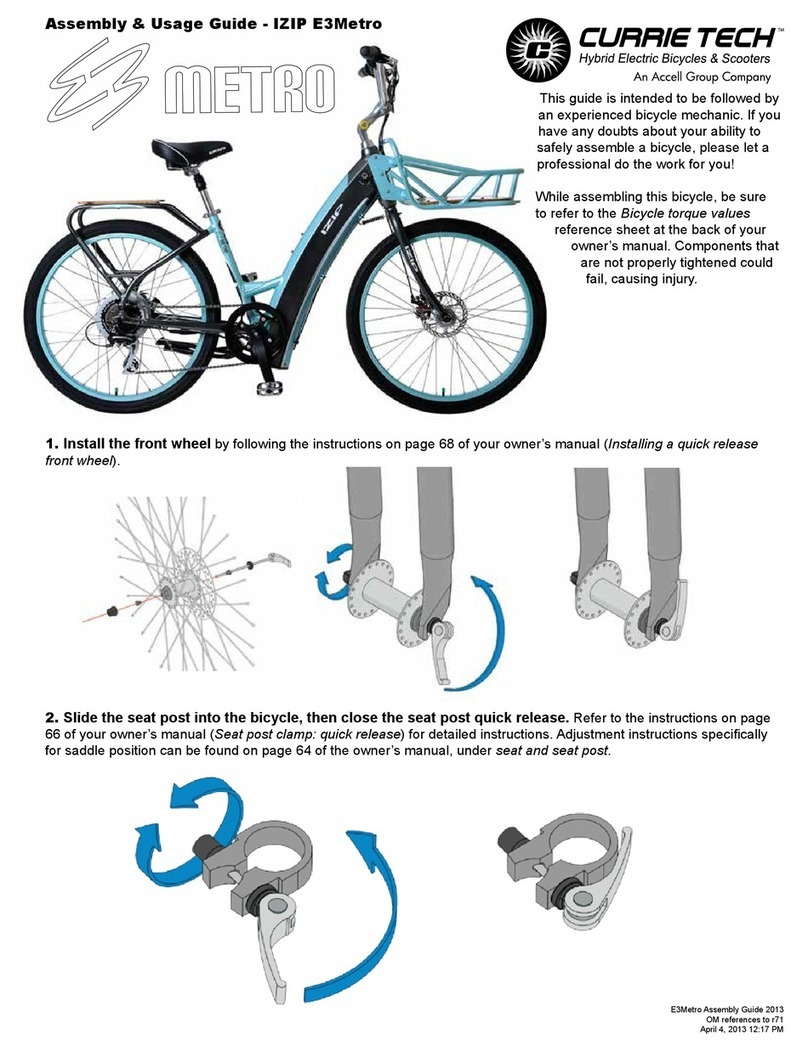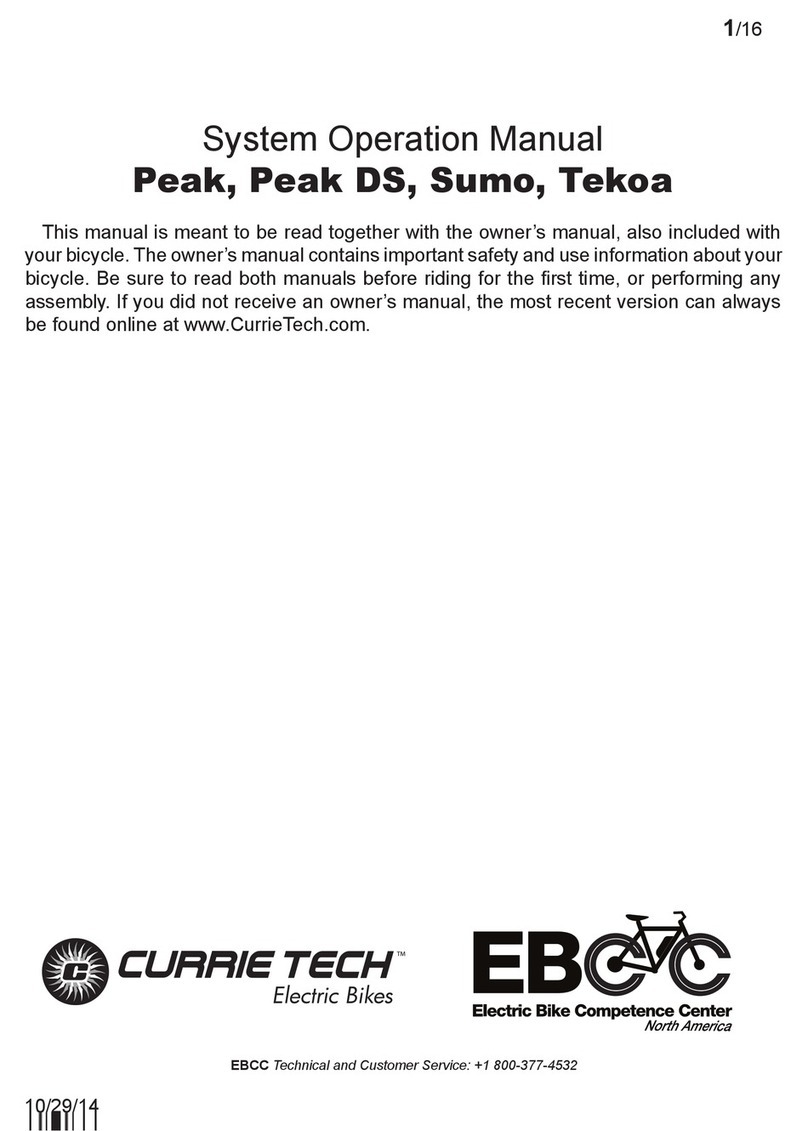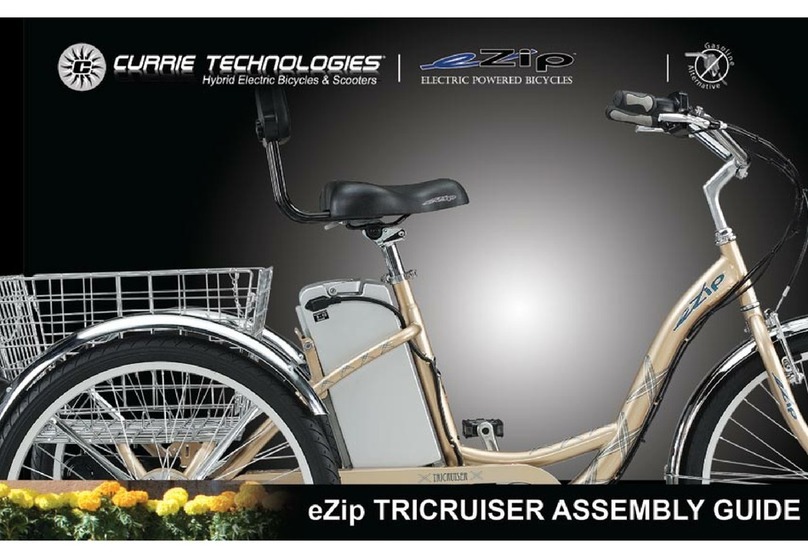9
8OM 2012 Last modified May 25, 2012 2:29 PM
PAS – Pedal Assist - A sensor ring and pickup mounted near the bottom bracket allow the bicycle to sense forward pedaling and
apply power. PAS+ adds a handlebar-mounted control box that allows the rider to select between different levels of assist.
•ViaUrbano(PAS+only)
TAG – Twist and Go - A rider-controlled system, the motor activates only when the handlebar throttle is turned.
•Sereno,Tricruiser,ViaMezza
– Pedal Assist or Twist and Go - A handlebar-mounted button allows selection of PAS or TAG modes.
replaces the button with a handlebar-mounted control box that allows the rider to select between assist levels or switch to TAG.
•Coastline,EcoRide,Skyline,Trailz,ViaLento,ViaRapido,Zuma;E3Metro(PAS+/TAG)
TMM – Torque Measurement Method - A sensor mounted in the rear dropout measures pedaling force and naturally adds motor
power in response to rider effort.
•TrekkingEnlightened,UrbanCruiserEnlightened,Ultra
BATTERY SYSTEMS
RMB – Rack Mounted Battery with Sealed Lead Acid (SLA) cells - Two SLA battery packs sit vertically in the rack.
•Coastline,Trailz,ViaLento
RTMB – Rack Top Mounted Battery with Lithium Ion (Li Ion) cells - A single Li-Ion battery pack lies horizontally inside the rack.
•EcoRide,ViaRapido,Zuma
STB –Seat Tube Battery with Sealed Lead Acid (SLA) or Lithium Ion (Li Ion) cells - A single battery pack is mounted behind the
seat tube.
•Tricruiser,ViaMezza,Skyline
Downtube (integrated) – Enlightened series, Lithium Ion (Li Ion) cells - A single Li Ion battery pack is hidden inside the
frame's downtube
•E3Metro,TrekkingEnlightened,Ultra,UrbanCruiserEnlightened,ViaUrbano
TERMINOLOGY
PART 1 - PARTS IDENTIFICATION
INDEX
Battery
Care and information . . . .42-43
Chargers. . . . . . . . . . . 44-48
Gauge . . . . . . . . . . . . . . 35
Terminal covers . . . . . . . . . 44
Brakes
Explanation . . . . . . . .116-117
Lever setup . . . . . . . . . . .72
Parts explosion (linear-pull) . . . 74
Setup (disc, Avid BB7). . . . 80-81
Setup (disc, Tektro) . . . . . 78-79
Setup (linear-pull) . . . . . . 75-77
Cables & cable housing . . . . 97
Care . . . . . . . . . . . . . 33-34
Chain . . . . . . . . . . .106-107
Components
RTMB . . . . . . . . . . . . . . 10
Enlightened . . . . . . . . . . .12
Folding. . . . . . . . . . . . . . 11
RMB . . . . . . . . . . . . . . . 13
Tricruiser. . . . . . . . . . . . . 14
Crankset . . . . . . .65,103-105
Currie Drive
Maintenance. . . . . . . . . . 108
Derailleurs
Front . . . . . . . . . . . . . . . 82
Rear . . . . . . . . . . . . . . . 83
Fenders
Front . . . . . . . . . . . . . . . 84
Rear . . . . . . . . . . . . . . . 85
Fit
Frame sizing. . . . . . . . . . . 17
Riding position. . . . . . . . 18-19
Fork
Assembly . . . . . . . . . . . .63
Suspension . . . . . . . .121-122
Fuses . . . . . . . . . . . . . . 51
Gears . . . . . . . See "Shifters",
"Wheels - Freewheel"
Handlebar
Assembly . . . . . . . . . . 60-61
Mounted components . . . . . . .
See "Brakes", "Throttles", "Shifters",
"Power switches - Handlebar", "Bat-
tery - Gauge", "PAS", "TMM"
Headset . . . . . . . . . . . . . 98
Maintenance checklists . . 87-88
Motor . . . . . See "Currie Drive"
PAS . . . . . . . . . . . . . . . 36
Pedals. . . . . . . . . 65, 101-102
Power switches
Handlebar . . . . . . . . . . . . 50
Standard. . . . . . . . . . . . . 49
Quick releases
Front Wheel . . . . . . . . . 68-69
Seatpost . . . . . . . . . . . 66-67
. . . . . . . 25-26, 110
Saddle. . . See "Seat & seatpost"
Safety . . . . . . . . . . . . 20-29
Seat & seatpost
Assembly . . . . . . . . . . 64-65
Detailed maintenance . . . 99-100
Quick release clamp. . See "Quick
release"
Shifters
Assembly . . . . . . . . . . . .62
Gears (how to operate) . . .30-32
Grip shifters . . . . . . . . . . . 96
Shifting (how to) . . . . . . 118-119
Stem
Assembly (quill) . . . . . . . . . 60
Assembly (threadless). . . . . . 61
Maintenance. . . . . . . . . 94-95
Terminology . . . . . . . . . . 9
Throttles . . . . . . . . . . . .40
Tires . . . . . See "Wheels - Tires"
TMM . . . . . . . . . . . . . . . 37
Torque requirements. . . 124-125
Troubleshooting . . . . . 111-115
Front (bolt-on) installation . . 70-71
Front (quick release). . See "Quick
release - Front Wheel"
Freewheel . . . . . . . . . . . 109
Hub adjustament . . . . . . . .93
Maintenance. . . . . . . . . 90-93
Rear (bolt-on) installation . . 70-71
Rear wheel removal . . . . . . . 71
Tires . . . . . . . . 91-93,120-121
RMB (2008) . . . . . . . . . . . 53
RMB (2009) . . . . . . . . . . . 54
RMB 2010 (with hub motor) . . . 57
RTMB 2009 . . . . . . . . . . . 55
RTMB 2010 (with hub motor) . . 58
TMM . . . . . . . . . . . . . . . 55
Via Mezza . . . . . . . . . . . . 52


